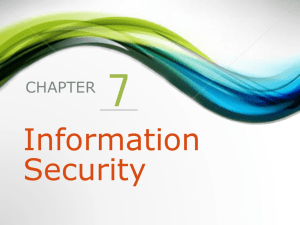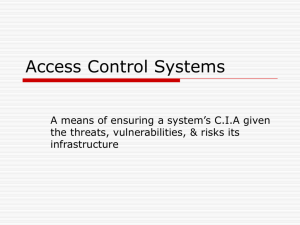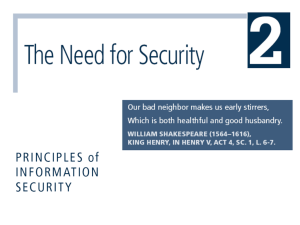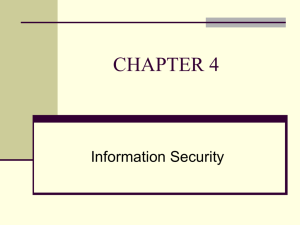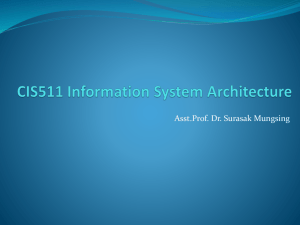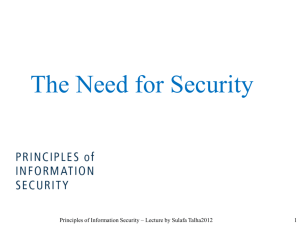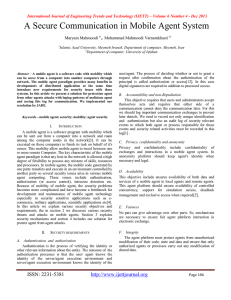Chapter 4
advertisement
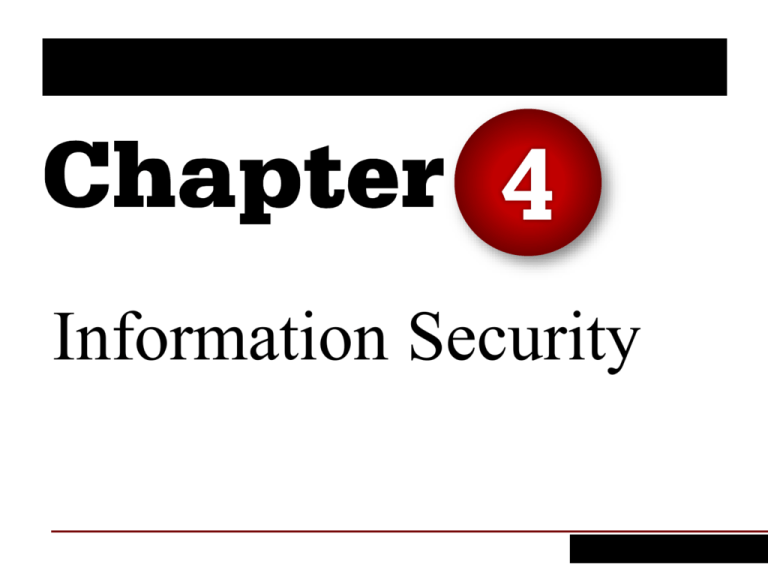
4 Information Security 1. 2. 3. 4. 5. Identify the five factors that contribute to the increasing vulnerability of information resources, and provide a specific example of each one. Compare and contrast human mistakes and social engineering, and provide a specific example of each one. Discuss the ten types of deliberate attacks. Define the three risk mitigation strategies, and provide an example of each one in the context of owning a home. Identify the three major types of controls that organizations can use to protect their information resources, and provide an example of each one. 1. Introduction to Information Security 2. Unintentional Threats to Information Systems 3. Deliberate Threats to Information Systems 4. What Organizations Are Doing to Protect Information Resources 5. Information Security Controls [ Opening Case Kim Dotcom: Pirate or Successful Entrepreneur? ] • • • • • • The Problem The Law The Legal Battles What We Learned from This Case The Results (in March 2013) What We Learned from This Case About [small] business 4.1 Small Businesses in Danger 4.1 Introduction to Information Security • • • • • Security Information Security Threat Exposure Vulnerability Introduction to Information Security • Five Factors Contributing to Vulnerability – Today’s interconnected, interdependent, wirelessly networked business environment – Smaller, faster, cheaper computers & storage devices – Decreasing skills necessary to be a computer hacker – International organized crime taking over cybercrime – Lack of management support 4.2 Unintentional Threats to Information Systems • Human Errors • Social Engineering Human Errors • Higher level employees + greater access privileges = greater threat • Two areas pose significant threats – Human Resources – Information Systems • Other areas of threats: – Contract Labor, consultants, janitors, & guards Human Errors • Common Human Error – Carelessness with Laptops – Carelessness with Computing Devices – Opening Questionable E-mail – Careless Internet Surfing – Poor Password Selection and Use – Carelessness with One’s Office Human Errors • Common Human Error – Carelessness with One’s Office – Carelessness Using Unmanaged Devices – Carelessness with Discarded Equipment – Careless Monitoring of Environmental Hazards 4.3 Deliberate Threats to Information Systems • • • • • • Espionage or Trespass Information Extortion Sabotage or Vandalism Theft of Equipment or Information Identity Theft Compromises to Intellectual Property 4.3 Deliberate Threats to Information Systems • Software Attacks • Alien Software • Supervisory Control and Data Acquisition (SCADA) Attacks • Cyberterrorism and Cyberwarfare Software Attacks • Remote Attacks Requiring User Action – Virus – Worm – Phishing Attack – Spear Phishing Attack • Denial of Service Attack • Distributed Denial of Service Attack Software Attacks • Remote Attacks Needing No User Action – Denial of Service Attack – Distributed Denial of Service Attack Software Attacks • Attacks by a Programmer Developing a System – Trojan Horse – Back Door – Logic Bomb Alien Software • Adware • Spyware – Keyloggers • Spamware • Cookies – Tracking cookies [about business] 4.2 Can Anonymous Be Stopped? [about business] 4.3 Cyberwarfare Gains in Sophistication 4.4 What Organizations Are Doing to Protect Information Resources • Risk • Risk Analysis • Risk Mitigation Risk Mitigation • Risk Acceptance • Risk Limitation • Risk Transference 4.5 Information Security Controls • • • • • Physical Controls Access Controls Communication Controls Business Continuity Planning Information Systems Auditing Physical Controls • Prevent unauthorized individuals from gaining access to a company’s facilities. – – – – – – – – Walls Doors Fencing Gates Locks Badges Guards Alarm systems Access Controls • Authentication • Authorization Authentication • • • • Something the user is Something the user has Something the user does Something the user knows – Passwords Basic Guidelines for Passwords • difficult to guess. • long rather than short. • They should have uppercase letters, lowercase letters, numbers, and special characters. • not recognizable words. • not the name of anything or anyone familiar, such as family names or names of pets. • not a recognizable string of numbers, such as a Social Security number or a birthday. Communication Controls • • • • • • • Firewalls Anti-malware Systems Whitelisting and Blacklisting Encryption Virtual Private Networking Secure Socket Layer Employee Monitoring Systems Business Continuity Planning • Disaster Recovery Plan • Hot Site • Cold Site Information Systems Auditing • Types of Auditors and Audits • How is Auditing Executed? [about business] 4.4 Fighting Botnets [ Closing Case Passwords Are No Longer Enough ] • • • • The Problem A Variety of Attempted Solutions The Result What We Learned from This Case
